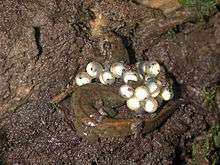Clutch (eggs)
A clutch of eggs refers to all the eggs produced by birds, amphibians, or reptiles, often at a single time, particularly those laid in a nest.
In birds, destruction of a clutch by predators (or removal by humans, for example the California condor breeding program) results in double-clutching. The technique is used to double the production of a species' eggs, in the California condor case, specifically to increase population size. The act of putting one's hand in a nest to remove eggs is known as "dipping the clutch".
Size
Clutch size differs greatly between species, sometimes even within the same genus. It may also differ within the same species due to many factors including habitat, health, nutrition, predation pressures, and time of year.[1] Clutch size variation can also reflect variation in optimal reproduction effort. In birds, clutch size can vary within a species due to various features (age and health of laying female, ability of male to supply food, and abundance of prey), while some species are determinant layers, laying a species-specific number of eggs. Long-lived species tend to have smaller clutch sizes than short-lived species (see also r/K selection theory). The evolution of optimal clutch size is also driven by other factors, such as parent-offspring conflict.
Clutch size recorded in ornithological field notes may or may not include lost or broken eggs.
Gallery
- Mallard (Anas platyrhynchos), very large clutch or possibly from two females
 Great black-backed gull (Larus marinus), small clutch
Great black-backed gull (Larus marinus), small clutch Masked lapwing (Vanellus miles), typical clutch
Masked lapwing (Vanellus miles), typical clutch- Common moorhen (Gallinula chloropus), small clutch
 Lesser spotted eagle (Aquila pomarina), typical clutch
Lesser spotted eagle (Aquila pomarina), typical clutch Feral pigeon (Columba livia domestica), typical clutch
Feral pigeon (Columba livia domestica), typical clutch European starling (Sturnus vulgaris), typical clutch
European starling (Sturnus vulgaris), typical clutch European goldfinch (Carduelis carduelis), large clutch
European goldfinch (Carduelis carduelis), large clutch Northern dusky salamander (Desmognathus fuscus), typical egg clutch
Northern dusky salamander (Desmognathus fuscus), typical egg clutch
See also
References
- ↑ Lack, David (1947): The significance of clutch-size (part I-II). Ibis 89: 302-352